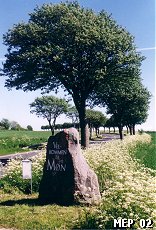insula-moenia.dk

insula-moenia.dk

On the 28th of December 1627, King Christian the 4th gave the citizens of Stege more land for agricultural use.
In 1648 Christian the 4th died and the 30-year-war ended, but King Frederik the 3rd started the wars against the Swedes.
During
the war against the Swedes in the years 1657-60, Møn and the other islands
in the south were for a long time left out of the war. But the Swedes were
a constant threat because supplies were shipped from the harbors of Møn to
the occupied Copenhagen.
After some minor attacks by the Swedes, which all had been defeated by the citizens
of Møn, they finally stood face to face with a numerous Swedish army on the
15th of January 1659.
The Swedes had planned to walk over the ice from Kalvehave on Zealand to Tjørnemarke
on Møn. The people on Møn however knew what was going on and held an 8 meters wide and 3
miles long opening in the ice. Due to this the Swedes could not manage to build a bridge
over the ice.
The defense forces of Møn fought well and the Swedes had to withdraw, not only
due to loss of men, horses and weapons but also because a strong snowstorm from
the southeast was very much on the side of the defense force of Møn.
Then, on the 29th of May 1659, the Swedes had become aware of a fordable place
between Bogø and Møn and the same day the crossing took place...
3000 Swedish soldiers got an easy fight against the "army" of Møn of 500 men -
citizens, peasants and soldiers.
The Swedes roamed the island after the conquering and destroyed almost everything
in their way. They settled down in Stege from where they plundered the entire
island and burned down the town hall with all its papers.
When the war was over and the Swedes had left Møn, the island had lost
244 farms - all burned down and further 67 farms were more or less destroyed,
the fields had not been sown and most of Møn´s population was gone. In
the beginning of the 16th century the population of Møn was about 2500, after
the war in 1660 this number was reduced to 670!
Not only Møn was effected, the whole country was drained and the national debt was huge.
King Frederik the 3rd introduced absolutism, the royal feudal lords disappeared and were replaced by counties. It was planned that the head of the county was to see to care forsituation within farming and trade to be improved, so that money could begin to roll into the national bank, but it apparently did not improve as fast as the King had suspected and he pledged the island to a Dutch by the name Gabriel Marselis in the year 1664 for the amount 100.000 rixdollar. Gabriel exploited the island so roughly during a period of 20 years, that both he and the harsh times were long remembered and talked about by the residents of Møn.
In 1684 King Christian the 5th redeemed the pledge and a commission was sent to the island. They only verified that the state of the island was terrible to say the least: Stege was halfway in ruins, there were many abandoned farms and the forests were nearly cut down completely. However, Møn was not to get a break until 12 years later!
In 1690 Plessen tore down what was left of the two gate towers at Skammestræde and Langestræde and the town wall to get stones to improve on Nygård and to build 400 chimneys to the Guard Houses, each chimney needed 300 stones. It is this demolition of Stege's fortress that is known as the "the biggest robbery in Møn's history". Though in the last standing gate tower, Mølleporten,he established a prison with two light and two dark cells but other than this alteration nothing was rebuilt in Stege. As the Colonel also was the head of the county he was to care for taxes to be collected, but he did not, so no money was gathered to the town and nothing was handed over to the national bank.
In 1696 a new commission was sent to Møn, the poor condition of the county was discovered, and Plessen was imprisoned.
All of Møn was in ruins, there was no administration in Stege, nothing worked properly, it could only get better.
The King spared the people of Møn of taxes for 2 years, but it would take 100 years before Møn had fully recovered from the damages caused by Plessen.
